Answering the Heart's Call
For many years, I wondered what it really meant to ‘follow one’s heart’. I was very curious to know what it felt like. I was certain it would be extraordinary, with an air of mystery. Something lofty and noble, a higher purpose. It would be a dramatic turning point after which all the pieces of the puzzle would fall neatly in place. I would no longer feel torn, there would be no guilt or self-doubt, no more bad decisions, and no future-anxiety. I was convinced it would bring clarity and peace, joy, fulfillment and perhaps, success. All the good stuff.
I finally found my calling around my forty-second birthday, but it wasn’t quite what I had imagined. Just when I'd begun to feel a sense of security and stability that I had missed for many years, I was let go at work. For reasons I didn’t understand, but that felt right, I started making slightly odd-looking wooden lamps with a few hand tools in a makeshift workshop in my apartment. I had these ideas for lamps popping into my head night and day that I couldn’t really stop or control. I felt compelled to make the lamps I was seeing, but it was easier said than done. I had to work each little detail out - the structure, dimensions, joinery, strength, stability, and so on in order to achieve the form I was seeing in my head. When I was stumped, which happened very often, I’d go online and look for answers or figure it out on my own. Many nights I’d lie awake trying to mentally solve a design problem, and this still happens whenever I start on a new design.
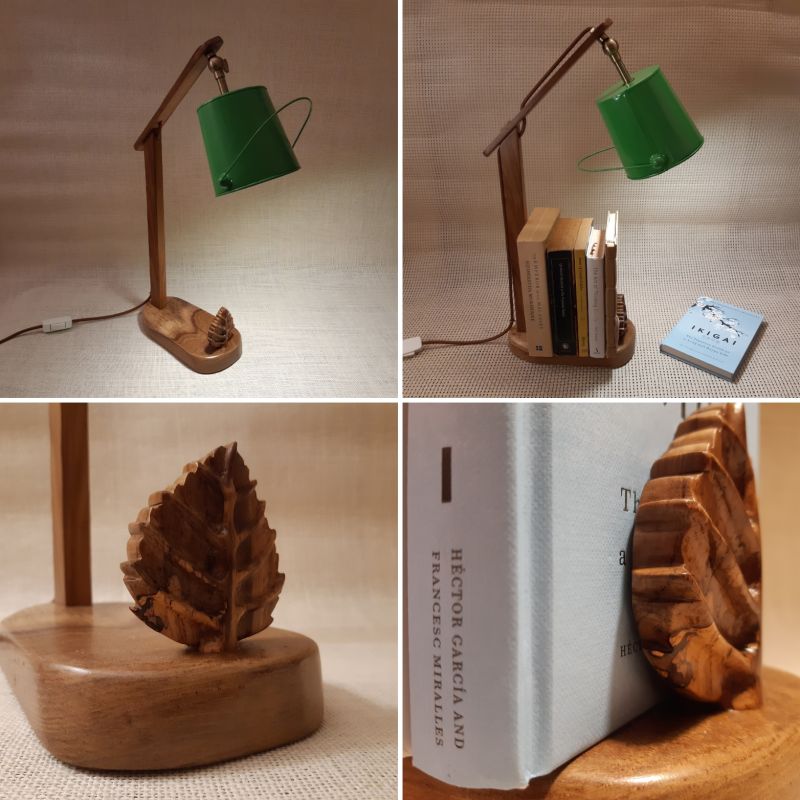 ATELIER, Multifunctional and adjustable desk lamp
ATELIER, Multifunctional and adjustable desk lamp
I didn’t learn design or woodworking formally, so I had to develop my own method, which to a large extent was informed by the constraints I was faced with: limited space, tools, capital, and know-how. If I had to give it a name, I’d call it “guerrilla woodworking” – trying to maximize impact with minimal resources, using a lean and adaptive approach bolstered with frequent improvisation and lateral thinking.
As a lamp designer and maker, my approach leans towards the natural, frugal, and functional. I try to use each piece of wood entirely, to avoid or minimize wastage. I enjoy developing new designs within self-imposed constraints, such as making a lamp using just a single strip of wood. I am also frugal with respect to my tools and workspace, choosing to work with only a few essential hand tools and not acquiring a new tool until I absolutely cannot do without it. I love the challenge of using less to do more – less wood, fewer joints, fewer tools - favoring the frugal and functional over the ornamental.
The lamps I make aren’t what most people would call conventional. They tend to be minimalist in design, almost spartan, and very often multifunctional. I love books and love making lamps that can hold books, because frankly, why not? They just go together in my head – lamps and books.
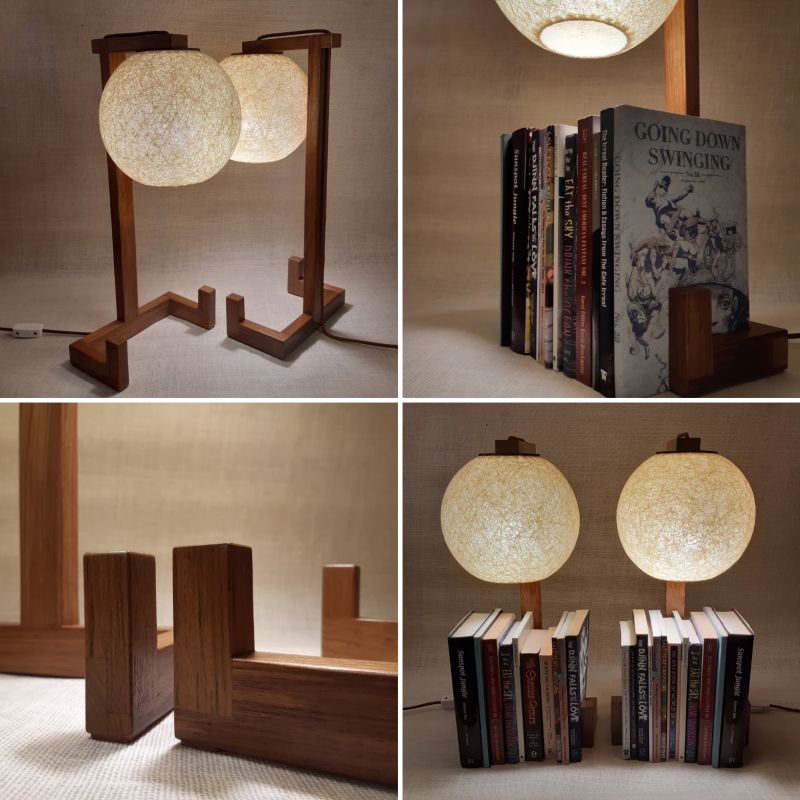 COVE, Multifunctional table lamps
COVE, Multifunctional table lamps
I work predominantly with teak wood because I love its rich, warm tones. Teak wood has an inherent natural beauty, and every piece of wood has a history - its unique grains, knots, scars and cracks offer clues about its journey and all that it has lived through. I often look for rejects at the sawmill - the misfits and left-behinds - those odd pieces of wood that nobody wants because of visible ‘flaws’ or irregularities. I try to use these pieces of wood in ways that highlight rather than conceal these features. I avoid using stains or polishes, opting instead for a clear, water-based finish that is safer for the environment and protects the wood while maintaining its natural appearance. I prefer to retain imperfections like dents, chipped edges or minor cracks that do not compromise the strength or stability of the piece.
I feel a certain empathy and kinship with these sawmill rejects. I’ve felt the sting of rejection several times, and it always made me think about worth or value. Sometimes that value is not obvious or immediately apparent. It takes time, effort and patience to allow something, an idea or a person, to blossom and express its potential. That opportunity doesn’t always come from the outside, it’s not something we can expect or control. But we can give it to ourselves, at least once, and see where it takes us. I feel the same way about these pieces of wood that no one wanted. No matter how flawed in appearance or how small in size, I attempt to work with the wood rather than on it. I’m always curious to see what emerges if I am gentle, patient and open to what it could become, even if it’s different from what I had envisaged. The gradual evolution of each piece is a journey I find tremendously enriching and fulfilling.
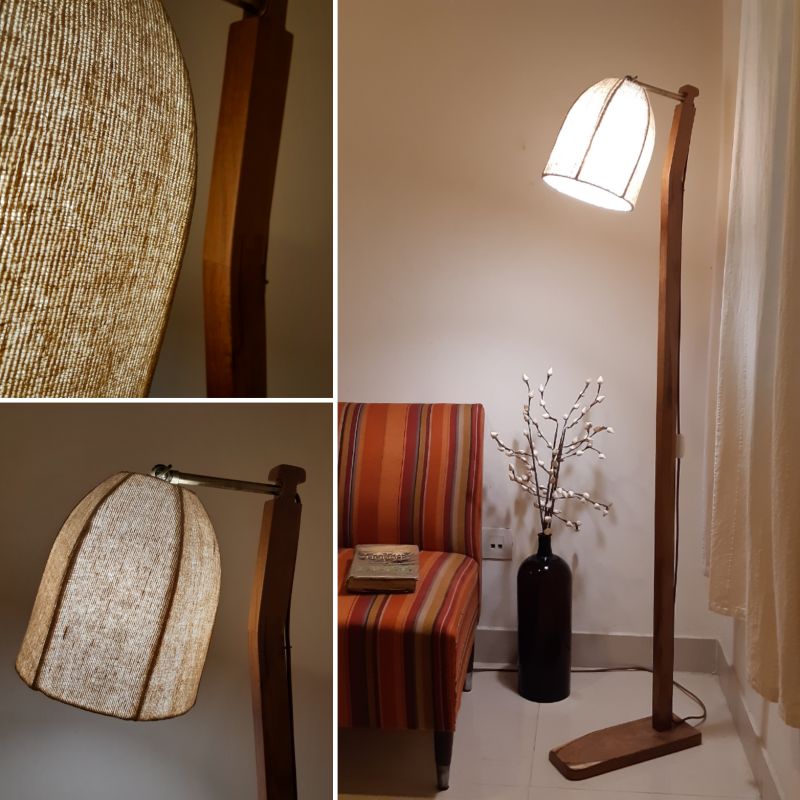 WILLOW, adjustable floor lamp
WILLOW, adjustable floor lamp
In 2019, I was invited to participate in an exhibition showcasing handcrafted artisanal products from across the country. It was the first time I was presenting myself and my work directly before such a large and discerning audience. I felt vulnerable and jittery, and was bracing myself for the rejection I was sure would follow. But, to my utter disbelief and delight, all my lamps were sold. My fondest memories of those five days are of visitors telling me that they loved stepping inside my stall – that they felt welcomed and comforted standing amidst all those lamps, bathed in that soft, warm light. To me, this was the bigger reward. It told me I must be doing something right and I must persevere on this path.
Putting my work out there, whether in person or on social media, was both challenging and intimidating. But it also opened up so many unexpected possibilities – from being invited to speak about my work and process at a reputed college of architecture, to being interviewed and featured in design magazines, and being approached to conduct workshops on woodworking. It’s extremely gratifying each time an old customer reaches out to buy more, or customers take the trouble to carry lamps back home to other cities, or when I’m requested to ship to other countries. I’ve felt especially honored when customers have bought lamps not for themselves but for their loved ones, because they wanted a gift that was truly unique.
When the pandemic hit in 2020 and we had lockdowns lasting months, I couldn’t step out to buy wood for lamps. That’s when I started experimenting with whittling, using leftover pieces of scrap wood. I carved miniatures with the small bits and spoons with the larger ones. Whittling tools are expensive and hard to come by here in Bengaluru, so I ended up using a vegetable carving knife with a thin, curved blade. After much trial and error, and a few painful accidents, I learned how to get the best out of it.
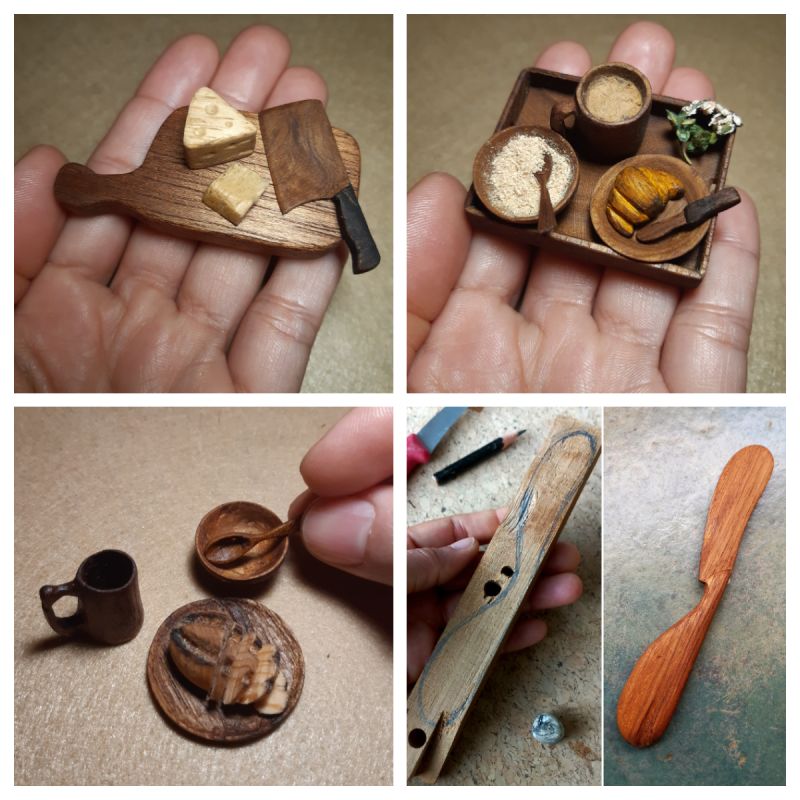 Assorted miniatures, Anoo Kulkarni
Assorted miniatures, Anoo Kulkarni
I’ve questioned my decision more than once over these years, especially early on. Why did I choose to do this? Why did I not see it as a whim, an impulsive act born of frustration, or a mid-life crisis? Why did I risk so much to do something that was completely new to me? Looking back now, I know why. I decided to pursue it because something about this felt very real to me, authentic and deeply personal. There was this compelling curiosity that I hadn’t felt in a long time, that made me restless to do more, learn more. This was the direction I knew I must take, even if I had to do it alone, with no idea how or where to begin. To quote Dr. Martin Luther King, Jr., “Take the first step in faith. You don't need to see the whole staircase, just take the first step.”
All parts of me feel aligned on this journey. There is no inner conflict, no dissonance, nothing else I’d rather be doing. I’m not suggesting that there is no uncertainty, doubt or future-anxiety. They show up every so often, and they probably always will. But I find that most times these uncertainties are about the how of it, not the why. Now, the doubts and questions do not drain me of energy, but drive me to figure things out and find a solution – they play a more positive and productive role. This is all part of the journey. I often lose track of time when I work. I am focused and at peace when I’m in my little workshop, tools in hand, feeling the energy in the wood on my workbench. It’s best expressed as being in a state of flow, the phenomenon researched and described at length by Mihaly Csikszentmihalyi.
I’ve been doing this full-time for five years. I’m not sure how this journey will unfold over the next few years, or even next week. The future hasn’t become any clearer and life hasn’t gotten any easier after making the choice to follow my heart. But it’s the happiest I have ever been, and I can’t imagine doing anything else. I don’t know if I will make enough money doing this, but that’s not why I started doing it in the first place. If money were the objective, I would have gone about things very differently. However, because this is the only activity I am now engaged in, and it takes up all of my time and energy, I do need to sell what I make, and sell enough of it on a regular basis to make a living. Right now, it’s not nearly enough to cover rent and expenses, and I’m still dipping into my dwindling savings. At some point I might be forced to stop and look for a job to pay the bills. I know that would feel like death. I truly hope I never reach that point, and I have to work hard to try and ensure that doesn’t happen. At the same time, I am very aware of the fact that this is a luxury and I’m in a position of privilege to be able to pursue it right now. Not everyone has the opportunity to discover their calling, or the freedom and wherewithal to pursue it. It is both a gift and a responsibility, not to be taken lightly or taken for granted.
Here are some of the things I’ve learned along the way:
Everyone can be creative. It is not a special gift that only a select few are born with. This lesson has been very empowering. I learned to trust in my ability to make or do things on my own, to keep trying and to keep myself open to possibilities. HOWEVER, creativity is also very hard work. You have to keep at it, be willing to fail and to try again.
Being creative doesn’t have to be expensive or complicated. You can create something new and useful with the most basic tools and materials.
The creative process is active, present and transformative. To me, the process of creating something is just as valuable as the final creation. Every problem solved, every question answered, every restless night and frustrating day, every sudden insight and the thrill of finding a way where there was no obvious path, is a reward in itself. I have also found that a relaxed and flexible approach really helps, where I am not too heavily invested in one specific outcome or method at the cost of finding a better solution.
Even junk can be wealth to a creative mind. Almost everything has the potential to be re-used in a new way. Functional fixedness often gets in the way of us seeing new and unconventional uses for everyday objects.
Constraints can be a deterrent, or an impetus to creativity depending on how you look at it. Working within constraints helped me develop the ability to think laterally. When I want to make something new, I often impose rules and constraints such as the materials I can use, or the amount of time or money I can spend on it. I find myself coming up with interesting and unusual solutions, and the process is immensely satisfying and insightful.
All of these insights equipped me to venture into woodworking more readily, with more curiosity than fear, and with as strong an interest in the process as in the end product.
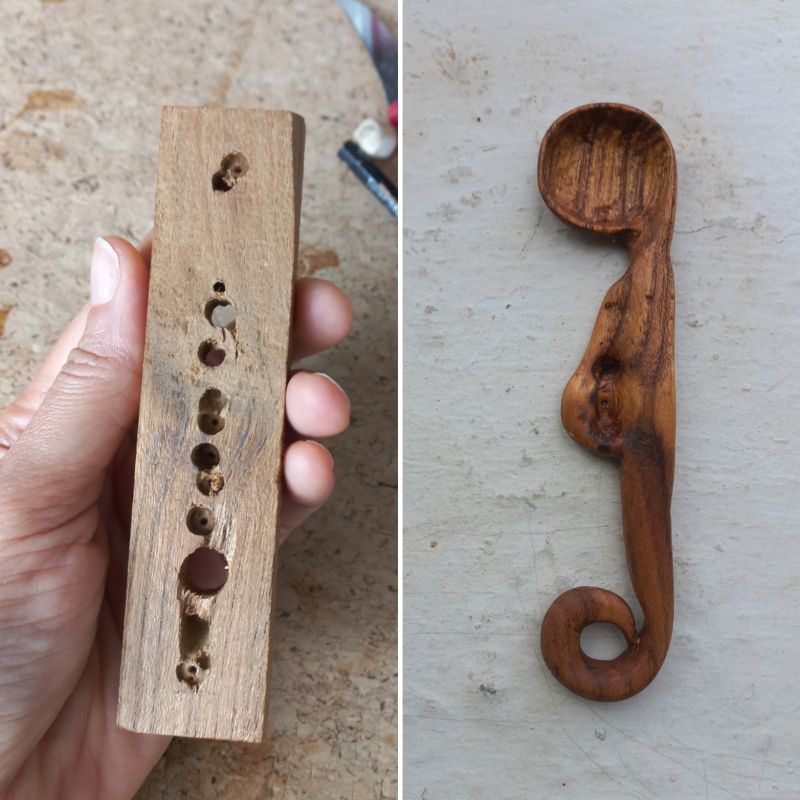 Handcarved Spoon, The Woman in the Embryo, the Embryo in the Woman
Handcarved Spoon, The Woman in the Embryo, the Embryo in the Woman
When I was a child, one of my most cherished possessions was a little carpentry set that had simple but functional hand tools. I recall tinkering with wires, switches and bulbs when I was just nine or ten. I guess my calling was evident even then, clear as day. It was a natural part of me, like my nose or my voice. I didn’t see it as separate from myself, or feel the need to give it a name, which makes me wonder if others have noticed this too, in their lives. Maybe it’s worth looking back at our childhoods to see if there’s some truth in this. What were the things I did spontaneously, without having to be asked? Which activity made me lose track of time? Which activity did I engage in because I couldn’t stop myself from doing it? What did I enjoy doing by myself, for its own sake, even when there was no reward or praise at the end of it, even when no one was watching? Maybe, just maybe, that was the call of my heart – the path on which I would feel most aligned and integrated. If we can listen to that call with a little more curiosity, and answer it with a little more courage, perhaps we can gift ourselves the opportunities we’ve been waiting for.
***
For more inspiration, join a special circle with Anoo Kulkarni this Sunday, "When Quitting Opens a Door." More details and RSVP info here.
All photographs courtesy Anoo Kulkarni. Anoo Kulkarni is a self-taught woodworker and designer-maker based in Bengaluru, India. Working with hand tools, she makes one-off lamps under the brand name A Gentle Light. She also makes hand-carved miniatures and tableware using upcycled scrap wood. Her work can be seen at www.agentlelight.com and on Instagram @a.gentle.light
SHARE YOUR REFLECTION
4 Past Reflections


On Jul 18, 2022 Dr.Cajetan Coelho wrote:
At Anandwan a self-trained carpenter by name Shri Chandramani Maharana has become a legend in the history and folklore of the seven decades old MSS Warora. Using one normal original hand and the other an artificial one which he himself designed and fitted below his amputated elbow, Chandramani Ji has worked for decades creating beautiful small and large wooden artefacts, all displayed in the museum of the community. "Constraints can be a deterrent, or an impetus to creativity depending on how you look at it" - writes woodwork specialist Anoo Kulkarni.

On Jul 13, 2022 Patrick Watters wrote:
As we work to create light for others, we naturally light our own way.
- Mary Anne Radmacher -


On May 9, 2023 Jody Lowry wrote:
Post Your Reply